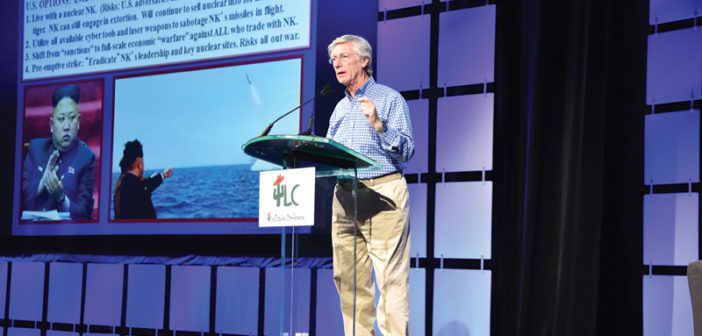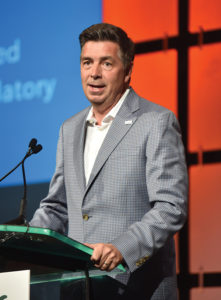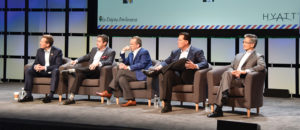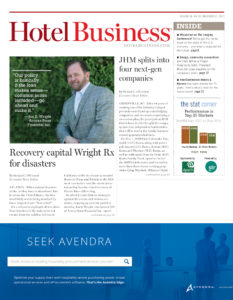PHOENIX—The economy is strong, and it’s expected to grow even more, according to analysts. In addition to a positive economic outlook, there’s something else the industry can look forward to—and it’s consumer related.
“As you can imagine, anybody looking out for the next 18-24 months, you know that you’re going to have to navigate through a minefield of economic, political and geopolitical hazards,” said Bernard Baumohl, chief global economist at The Economic Outlook Group, an advisory services firm specializing in forecasting the United States and international economies, during a session at The Lodging Conference, held here at the Arizona Biltmore, a Waldorf Astoria Resort. “They’re going to be part of a lot of challenges that we’re all going to be facing over the course of the next two years. It makes it more difficult for us sometimes to calibrate just what the economy’s going to do.” What’s the probability of recession? “I would give it no more than 25%,” he said.
During his presentation, he pointed out three key takeaways. The first: The economy is expected to grow. “We’re expecting the economy to grow about 2-3% over the course of the next three years through 2019,” he said. More than likely, the economy will grow between 2.5-3%, according to his firm.
“It’s largely because we’re seeing a build up of domestic demand here in the United States, and it’s being supported too by this tailwind, this extra tailwind that we’re getting from the economic rebound we’re seeing overseas,” he said. “Together, they will provide a very good springboard for how the U.S. economy is going to perform over the course of the next three years.”
His second takeaway: The economy will continue to grow whether or not there’s a tax cut, which some in the industry expect to pass sooner rather than later. For instance, after Baumohl’s session about the economic outlook, Chip Rogers, president and CEO of AAHOA, said the following on tax reform: “I am extremely optimistic that Congress will pass a significant tax cut by Christmas.”
The third key point from Baumohl’s session: the rate of inflation. “Third, and I think most importantly, really quite intriguing, is that we see the rate of inflation, consumer prices, still being very tame over the course of the next two years,” he said. “It’s largely because there’s some fundamental, structural changes that have taken place that have altered the dynamics of shaping inflation.” And, he noted, this isn’t restricted to the U.S. either.
“We’re seeing it in Europe,” Baumohl said. “We’re seeing it in Japan. We’re seeing it in the United States. It’s not due to any temporary factors. I think there’s something much more substantial, and as a result of that, we expect interest rates, both short-term and long-term rates, to inch up—but inch up slowly—and, ultimately, it will peak out at levels much lower than historical patterns.”
There are two caveats to his analysis. “The first caveat is we avoid a war on the Korean peninsula,” he said. The second caveat is related to the next Federal Reserve chair. According to Baumohl, the forecast holds if President Trump nominates someone who believes in interest rates rising gradually. (The president recently nominated Jerome Powell, a member of the Fed’s board of governors since 2012, for the position. If Powell is confirmed by the Senate, he is expected to continue current Chair Janet Yellen’s gradual approach to raising interest rates.)
Currently, we’re in the ninth year of economic expansion, the third longest expansion in the country’s history (at least going back to 1854). “If this expansion continues past March of next year, it will be the second longest, and if we can get it all the way past June of 2019, then we’re in the number-one spot,” Baumohl said. He is projecting three potential scenarios.
President Trump, his economists and Republicans have been touting the first potential outcome. In their view, the economy will grow 4-6% on a sustained basis if tax cuts are passed, infrastructure spending is built up, regulations are rolled back and trade deals are overhauled, Baumohl noted.
“Scenario B, as I outlined earlier, is 2-3% growth—that’s because we expect the tax cuts to be much, much more modest when they’re passed, but there are also some issues concerning the geopolitical framework or tensions that might also have an attenuating effect on economic activity,” the economist explained.
The last potential scenario is when “the party’s over,” Baumohl said. This could occur if a combination of factors comes into play: a crippled presidency, an all-out trade war or a major geopolitical eruption, which “could, then, finally, just completely shove the economy off course.”
Consumers will continue to be the main engine of economic growth for the next two years; they’re nearly 70% of all economic activity. “The key thing here—jobs,” he said. “Job creation is the single most important report card on the economy, and that is still going to remain very strong next year. Economic positives: job market is strong, unemployment is down and employers are struggling to fill positions, mainly due to the lack of skilled labor.”
The good news for the hospitality industry is the consumer is changing. How many cellphones, cars and electronic goods can the average consumer actually buy?
“This is what’s going to be interesting to watch over the next few years,” Baumohl pointed out. “I believe there’s going to be a change in the composition of what consumers will be spending. It’s going to be less on collecting stuff and more on services. We’re going to be seeing greater discretionary spending on life experiences. They’re going to be doing more travel. This is going to be a greater benefit now to the hospitality industry.” HB




